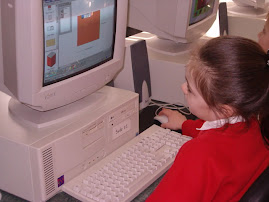
What are ICTs and what types of ICTs are commonly used in education?
ICTs stand for information and communication technologies and are defined, for the purposes of this primer, as a “diverse set of technological tools and resources used to communicate, and to create, disseminate, store, and manage information.” These technologies include computers, the Internet, broadcasting technologies (radio and television), and telephony.
In recent years there has been a groundswell of interest in how computers and the Internet can best be harnessed to improve the efficiency and effectiveness of education at all levels and in both formal and non-formal settings. But ICTs are more than just these technologies; older technologies such as the telephone, radio and television, although now given less attention, have a longer and richer history as instructional tools. For instance, radio and television have for over forty years been used for open and distance learning, although print remains the cheapest, most accessible and therefore most dominant delivery mechanism in both developed and developing countries. The use of computers and the Internet is still in its infancy in developing countries, if these are used at all, due to limited infrastructure and the attendant high costs of access.
Moreover, different technologies are typically used in combination rather than as the sole delivery mechanism. For instance, the Kothmale Community Radio Internet uses both radio broadcasts and computer and Internet technologies to facilitate the sharing of information and provide educational opportunities in a rural community in Sri Lanka. The Open University of the United Kingdom (UKOU), established in 1969 as the first educational institution in the world wholly dedicated to open and distance learning, still relies heavily on print-based materials supplemented by radio, television and, in recent years, online programming. Similarly, the Indira Gandhi National Open University in India combines the use of print, recorded audio and video, broadcast radio and television, and audio conferencing technologies.
What is e-learning?
Although most commonly associated with higher education and corporate training, e-learning encompasses learning at all levels, both formal and non-formal, that uses an information network—the Internet, an intranet (LAN) or extranet (WAN)—whether wholly or in part, for course delivery, interaction, evaluation and/or facilitation. Others prefer the term online learning. Web-based learning is a subset of e-learning and refers to learning using an Internet browser (such as Netscape or Internet Explorer).
What is blended learning?
Another term that is gaining currency is blended learning. This refers to learning models that combine traditional classroom practice with e-learning solutions. For example, students in a traditional class can be assigned both print-based and online materials, have online mentoring sessions with their teacher through chat, and are subscribed to a class email list. Or a Web-based training course can be enhanced by periodic face-to-face instruction. “Blending” was prompted by the recognition that not all learning is best achieved in an electronically-mediated environment, particularly one that dispenses with a live instructor altogether. Instead, consideration must be given to the subject matter, the learning objectives and outcomes, the characteristics of the learners, and the learning context in order to arrive at the optimum mix of instructional and delivery methods.
What is open and distance learning?
Open and distance learning is defined by the Commonwealth of Learning as “a way of providing learning opportunities that is characterized by the separation of teacher and learner in time or place, or both time and place; learning that is certified in some way by an institution or agency; the use of a variety of media, including print and electronic; two-way communications that allow learners and tutors to interact; the possibility of occasional face-to-face meetings; and a specialized division of labor in the production and delivery of courses.”
What is meant by a learner-centered environment?
The National Research Council of the U.S. defines learner-centered environments as those that “pay careful attention to the knowledge, skills, attitudes, and beliefs that learners bring with them to the classroom.” The impetus for learner-centeredness derives from a theory of learning called constructivism, which views learning as a process in which individuals “construct” meaning based on prior knowledge and experience. Experience enables individuals to build mental models or schemas, which in turn provide meaning and organization to subsequent experience. Thus knowledge is not “out there”, independent of the learner and which the learner passively receives; rather, knowledge is created through an active process in which the learner transforms information, constructs hypothesis, and makes decisions using his/her mental models. A form of constructivism called social constructivism also emphasizes the role of the teacher, parents, peers and other community members in helping learners to master concepts that they would not be able to understand on their own. For social constructivists, learning must be active, contextual and social. It is best done in a group setting with the teacher as facilitator or guide.
Retrieved from "http://en.wikibooks.org/wiki/ICT_in_Education/Definition_of_Terms"
Work shop for the teachers would be conducted, to show the importance of ICT in education, it will be a power point presentation through the multimedia, here the definition of ICT, its integration with education, a comparative study of discrete vs. integrated approach and the role of teachers will be discussed it will then be followed by an activity.
A word document of the presentation is as follows.
Definition of ICT:
• ICT is a combination of Information Technology (IT) and Communication Technology (CT):
• Information Technology (IT) is the term used to describe items of equipment (hardware) and computer programmes (software) that allow us to access, retrieve, store, organize, manipulate, and present information by electronic means.
• Communication Technologies (CT) is the term used to describe telecommunications equipment through which information can be sought and accessed, for example, phones, computer modems and faxes.
• The use of ICT in education is also referred to as E-learning, Online Learning, Computer based teaching/training, Networked Learning, Web-based learning, or Virtual Learning.
Why? ICT in Education:
• ICT in education offered a promise to revolutionize education. However, research indicates that ICT has not had a revolutionary impact on the classrooms. The impact of ICT on education is yet to be seen.
• In a typical Pakistani classroom you will find children sitting in rows of desks, either listening attentively to the teacher’s lecture or copying diligently from the blackboard. Or you will find students patiently waiting for their turn to speak in class. Knowledge is transferred from the experts and the books to the students. The content to be taught is determined by curriculum design experts and often comprises delivery of factual information, which is either already outdated or will be outdated soon.
• Memory recall remains the focus of ‘testing’ in schools. Computers are usually not available in classrooms and are used in offices for increased productivity of the administrative staff. Occasionally students are given access to computers during lab periods, where they find information from the web and copy it into their presentations or reports.
• However, the environment outside the schools, show a different picture altogether; for instance, we notice computers every where. A large majority of the children either own a mobile phone or have at least one family member who owns one. They use mobile phone use to ‘text’ or ‘sms’ their friends or chat online. When they switch on TV they watch the latest discoveries in bio-and multimedia technologies.
• They use i-pods or MP3 players for listening to songs, and use play-station or X-box for playing games. Using google search they find the reviews of all the up coming movies of their favorite stars and download songs and videos from websites or through peer-to peer network or sign an online petition against human rights violations. These children are connected and information rich.
• Clearly there seems to be a conflict between their life out side and inside the schools. The needs of today’s children have changed. But these changed needs are perhaps not reflected in our teaching and learning programmes.
Activity:
• Reflect on your teaching: Do you think your teaching and learning provides students the necessary experiences to equip them with knowledge, skills and attitudes essential to their survival in the information age?
• Is ICT the change you want in your school? Or is ICT a catalyst for change that you wish to see? What is the change you wish to see in your school and children and why?
Discrete Subject V Integrated Approach:
• The subject teachers and ICT teachers plan lessons and assessment together, which helps teachers of other subjects to enhance ICT skills and ICT teachers learn about subject areas.
• In a hybrid approach, ICT is taught as a subject as well as integrated into a few curriculum areas. You can start with a few subjects. For instance, you can form teams of ICT and subject teachers to develop ICT integrated projects for a term or an academic year.
• The teams can work together throughout the year or semester to implement the project. By working in a team, the ICT teacher will gain an understanding of the subject area and the subject area teachers will develop ICT skills and attitude.
• Together both teachers can learn how ICT can support learning in a more meaningful way. The ICT teachers will need professional development in general education. Like wise the subject teachers will need training of ICT skills. Accordingly an on-going professional development plan for all the teachers will be necessary
Role of Teachers:
• In short, in an ICT integrated class, teachers are viewed as instructors, demonstrators, project manager, and consultant, provider of resources, a questioner, an explainer, an observer and a co-learner. There is research evidence that suggests that while working with ICT many teachers shift the locus of control to the students and computers and intervene carefully to scaffold students learning. All these findings call for rethinking the roles and responsibilities of the teacher in the ICT integrated classrooms.
Conclusion:
• ICT are tools and technologies that we commonly use. These technologies have brought about several changes in our work and living environment. Due to the rapid changes, the future work and living environment is unpredictable. So the knowledge, skills and attitude currently taught in schools is not sufficient.
• We need to teach new skills, knowledge and attitude. Therefore, it becomes important to use and teach ICTs as part of the curriculum. Integration of ICT with education allows an opportunity to transfer skills and learning from one context to the other.
• While a hybrid approach may be useful now, the aim should be integration of ICT with curriculum. It is clear that having access to computers does not mean that computers will automatically be integrated with subject areas. Computer subject integration requires time, effort and commitment both from the schools and teachers.





































_JPG.jpg)
_JPG.jpg)
_JPG.jpg)
_JPG.jpg)
_JPG.jpg)

1 comment:
This is very impressive. The point you made of posting the information on the blog is good. It will be a learning experience to a lot of Teachers and parents who wishto know about ICT in teaching.
Post a Comment